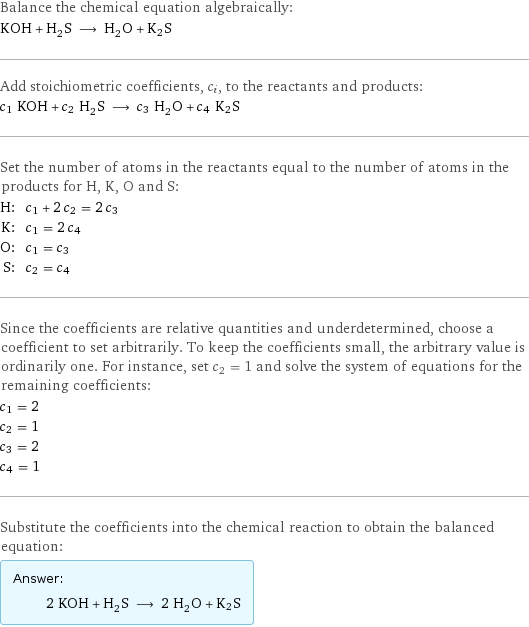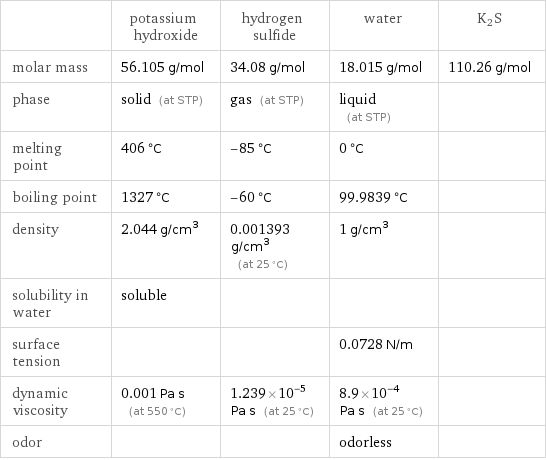Input interpretation

KOH (potassium hydroxide) + H_2S (hydrogen sulfide) ⟶ H_2O (water) + K2S
Balanced equation

Balance the chemical equation algebraically: KOH + H_2S ⟶ H_2O + K2S Add stoichiometric coefficients, c_i, to the reactants and products: c_1 KOH + c_2 H_2S ⟶ c_3 H_2O + c_4 K2S Set the number of atoms in the reactants equal to the number of atoms in the products for H, K, O and S: H: | c_1 + 2 c_2 = 2 c_3 K: | c_1 = 2 c_4 O: | c_1 = c_3 S: | c_2 = c_4 Since the coefficients are relative quantities and underdetermined, choose a coefficient to set arbitrarily. To keep the coefficients small, the arbitrary value is ordinarily one. For instance, set c_2 = 1 and solve the system of equations for the remaining coefficients: c_1 = 2 c_2 = 1 c_3 = 2 c_4 = 1 Substitute the coefficients into the chemical reaction to obtain the balanced equation: Answer: | | 2 KOH + H_2S ⟶ 2 H_2O + K2S
Structures

+ ⟶ + K2S
Names

potassium hydroxide + hydrogen sulfide ⟶ water + K2S
Equilibrium constant
![K_c = ([H2O]^2 [K2S])/([KOH]^2 [H2S])](../image_source/6c7085051d5dc52b0c6803e065dce276.png)
K_c = ([H2O]^2 [K2S])/([KOH]^2 [H2S])
Rate of reaction
![rate = -1/2 (Δ[KOH])/(Δt) = -(Δ[H2S])/(Δt) = 1/2 (Δ[H2O])/(Δt) = (Δ[K2S])/(Δt) (assuming constant volume and no accumulation of intermediates or side products)](../image_source/ef194c99227c41643a21252921ecac98.png)
rate = -1/2 (Δ[KOH])/(Δt) = -(Δ[H2S])/(Δt) = 1/2 (Δ[H2O])/(Δt) = (Δ[K2S])/(Δt) (assuming constant volume and no accumulation of intermediates or side products)
Chemical names and formulas

| potassium hydroxide | hydrogen sulfide | water | K2S formula | KOH | H_2S | H_2O | K2S Hill formula | HKO | H_2S | H_2O | K2S name | potassium hydroxide | hydrogen sulfide | water |
Substance properties

| potassium hydroxide | hydrogen sulfide | water | K2S molar mass | 56.105 g/mol | 34.08 g/mol | 18.015 g/mol | 110.26 g/mol phase | solid (at STP) | gas (at STP) | liquid (at STP) | melting point | 406 °C | -85 °C | 0 °C | boiling point | 1327 °C | -60 °C | 99.9839 °C | density | 2.044 g/cm^3 | 0.001393 g/cm^3 (at 25 °C) | 1 g/cm^3 | solubility in water | soluble | | | surface tension | | | 0.0728 N/m | dynamic viscosity | 0.001 Pa s (at 550 °C) | 1.239×10^-5 Pa s (at 25 °C) | 8.9×10^-4 Pa s (at 25 °C) | odor | | | odorless |
Units
